Passenger cars
Severe hybrid engine oil testing
20 May 2025
12 October 2016
Evaluating the impact of lubricant formulation on wear performance
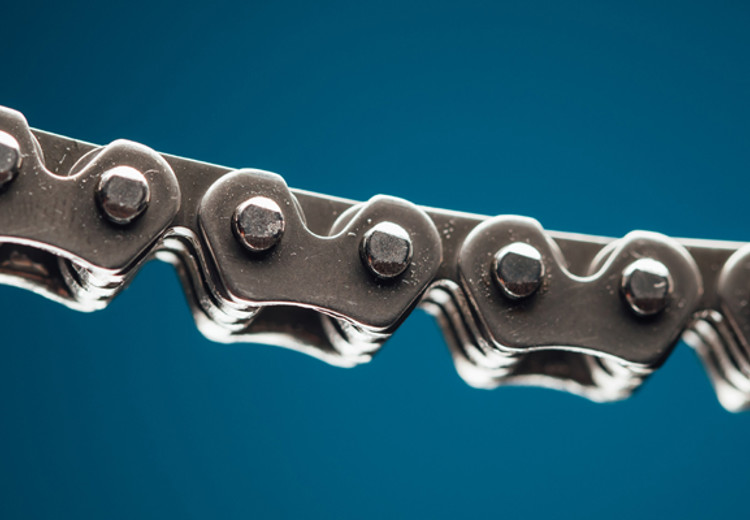
As timing chain wear becomes an area of increasing concern for OEMs, Ryan Rieth, Lubricant Development Technologist talks to Insight about the work Infineum has undertaken to better understand the impact lubricant formulations can have on this disruptive phenomenon.
In passenger car engines, the metal timing chain, which is located in the engine and lubricated by the engine oil, connects the crankshaft to the camshaft, which in turn controls the opening and closing of the intake and exhaust valves. Over extended periods of routine use the chain gradually elongates, which can eventually disrupt intake and/or exhaust valve timing, leading to engine inefficiency and increased emissions. As emissions legislation continues to tighten, OEMs need to minimise timing chain wear to help avoid noncompliance.
In the latest gasoline turbocharged direct injection (GTDI) vehicles, which have been designed to boost fuel efficiency, timing chain wear has been an ongoing area of concern.
To address this concern, a fired engine test is being developed for inclusion in the upcoming ILSAC GF-6 lubricant specification. The new test, developed by Ford, uses its 2.0L GTDI EcoBoost engine to evaluate the impact of oil quality on wear performance by measuring the length of the timing chain as a function of time.
Because engine oils contain additives that may limit surface degradation, Infineum conducted experiments to better understand timing chain wear and to assess the impact of lubricant formulations.
Silent and roller timing chains are the two most commonly used in passenger cars.
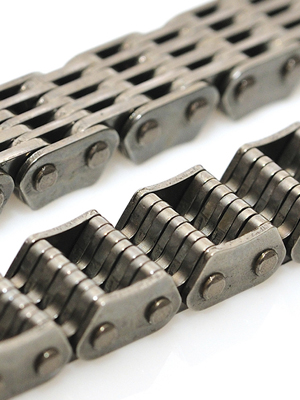
The silent chain is constructed using metal links, which are held in place by cylindrical pins. This type of chain is featured in the Ford engine used in the development of the ILSAC GF-6 chain wear test.
It is a common design with many advantages:
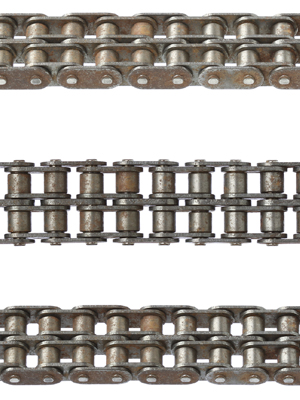
The roller chain is a more complex system, designed to reduce friction, in which link pins are reinforced by a roller support (or bushing) that accommodates freely rotating steel rollers. However, this type has several disadvantages:
Over extended periods of routine use, timing chains wear and slack develops between surfaces that are in immediate contact. This slack causes the chain to elongate and changes its pitch through the relative displacement of the links. Wear has been observed in the rollers and supports on a roller chain and in the pivot pins and links of a silent chain.
Some of the more notable chain contacts with respect to wear may vary depending on its construction.

Chain wear can be promoted by various mechanisms including the repeated pivoting motion of driving links or bushings against stationary connector pins, the presence of excessive amounts of soot and/or acid and the relationship to other timing components.
However, changes in engine operating conditions and oil viscosity mean the lubrication regime, and hence the wear rate, is not necessarily fixed.
Infineum has employed a variety of advanced techniques to examine the surfaces of chains to better understand the impacts of lubricant formulation on wear. Two oils, a relatively good and a poor performing oil, were run on the same ILSAC GF-6 fired engine test stand for different durations. A variety of analysis techniques were then used to evaluate the pins and links in the deconstructed timing chain.
Using a 3D profilometer for wear mapping, Infineum was able to pinpoint the areas of damage in multiple parts of the chain.
When comparing the wear scar results for the two test oils, deeper wear scars were observed on the pins for samples from longer tests using lower quality oil.
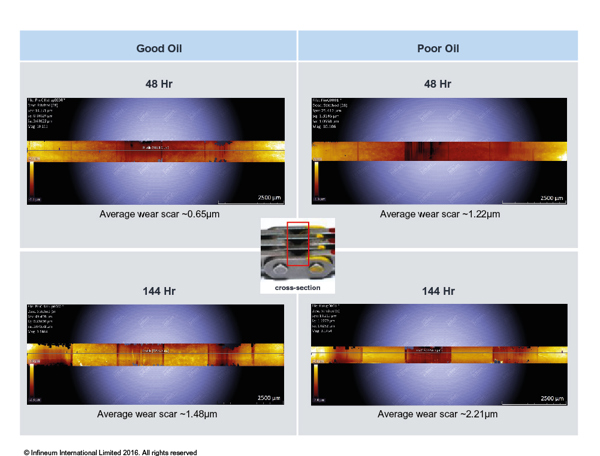
Wear scar results
These results are consistent with the chain stretch results obtained from the ILSAC GF-6 fired engine test.
Scanning electron microscopy (SEM) and optical microscopy were used to analyse the surfaces of chains. Defects were magnified in an effort to characterise them as being a result of scratching, etching, pitting or polishing. The location, type, and extent of distress can be used to better understand possible wear mechanisms.
For the two test oils, test duration and oil quality were observed to have an impact on the removal of machining marks, perpendicular to the direction of pivoting motion, in the holes of the links. In addition, the onset of polishing was noted.
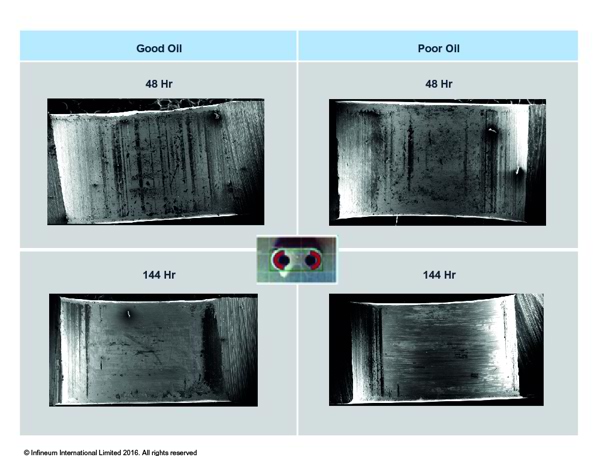
Analysing the surfaces of chains
In addition, energy-dispersive x-ray spectroscopy (EDS) was used to quantify elemental compositions at targeted surface locations. This technique can potentially be used to assess the effectiveness of formulations and to evaluate the base metallurgy for evidence of surface coatings, which may provide information about surface treatments for new hardware.
By using SEM and EDS to analyse the aged chains after fired engine testing, evidence of tribofilm on the links was noted. These findings could help to suggest the best formulation approach for future evaluations.
To isolate operational variables, which might promote wear, and to screen experimental oils easily and quickly, Infineum has designed and developed a motored screener rig. The configuration and dimensions of the rig match the timing chain system in the engine featured in the ILSAC GF-6 chain wear test. However, it is much easier to customise cam loadings, engine speed, oil pressure, and oil temperature for each rig test. In addition, the test duration for the rig has so far been much shorter than for the fired engine, which allows an increased sample throughput.
While the rig environment is considerably different from the fired engine test, operating conditions were observed to significantly influence wear rate. And, just as in the ILSAC GF-6 test, the rig was also able to discriminate between oils of varying quality.
Infineum maintains a strong commitment to further the understanding of timing chain degradation under various conditions. Because OEMs around the globe use different timing chains in their engines, the rig may, in certain circumstances, be a useful tool to help mimic specific hardware and operating conditions. In addition, test conditions can be varied to pinpoint the most impactful variables and to allow the faster identification of poor and good performing oils.
Future work is expected to focus on extending the scope of existing studies by assessing the extent of regional hardware variations and mapping the relationship of wear to engine operating conditions and surface chemistry.
Sign up to receive monthly updates via email